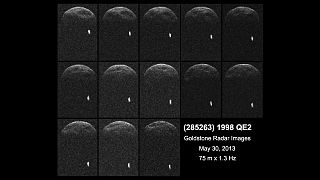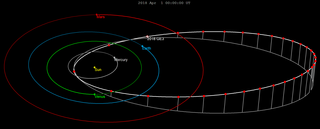
2010 GA6 is a micro-asteroid on an eccentric orbit, classified as a near-Earth object of the Apollo group. It was first observed on 5 April 2010, by astronomers of the Catalina Sky Survey at Mount Lemmon Observatory, Arizona, United States, four days before a close approach to Earth at 1.1 lunar distances on 9 April 2010. It has not been observed since.
2010 XC15 (also written 2010 XC15) is an Aten near-Earth asteroid and potentially hazardous object that spends most of its time inside of the orbit of Earth. It has an observation arc of 10 years and an Uncertainty Parameter of 1. It was discovered on 5 December 2010 by the Catalina Sky Survey at an apparent magnitude of 17.5 using a 0.68-metre (27 in) Schmidt.
(152680) 1998 KJ9 is a sub-kilometer asteroid, classified as near-Earth object and potentially hazardous asteroid of the Apollo group. Based on absolute magnitude, it is the third largest asteroid known to have passed closer than the Moon.

2013 ET is a near-Earth asteroid that was first observed on March 3, 2013, six days before its closest approach to Earth. It is estimated to be around 100 meters (330 feet) wide. The orbit of 2001 SY169 has been connected to 2013 ET extending the observation arc to 11 years.

(285263) 1998 QE2, provisional designation 1998 QE2, is a dark asteroid and synchronous binary system, classified as near-Earth object and potentially hazardous asteroid of the Amor group, approximately 3 kilometers in diameter. It was discovered on 19 August 1998, by astronomers of the LINEAR program at Lincoln Laboratory's Experimental Test Site near Socorro, New Mexico, in the United States. Its sub-kilometer minor-planet moon was discovered by radar on 30 May 2013.
2013 PJ10 is a Near-Earth asteroid that was discovered on 4 August 2013 in Observatorio Astronómico de La Sagra, with an estimated diameter of about 50 meters. At 02.18 GMT, 4 August 2013, this asteroid flew at a minimum distance from the Earth (371.4 thousand kilometers), accounting for 0.96 average radius of the lunar orbit, but until 2180 it will not approach the Earth closer than 3.2 million miles.
2009 RR micro-asteroid, classified as near-Earth object of the Apollo group. It was discovered on 11 September 2009 by the Catalina Sky Survey at an apparent magnitude of 19.5 using a 0.68-meter (27 in) Schmidt–Cassegrain telescope. 2009 RR was the only asteroid discovered before 2014 that was predicted to potentially pass inside the orbit of the Moon during 2014. The asteroid has an estimated diameter of 26 meters (85 ft) and is listed on the Sentry Risk Table. It is not large enough to qualify as a potentially hazardous object.
2014 AF5 (also written 2014 AF5) is an Apollo near-Earth asteroid roughly 5–10 meters in diameter that passed less than 1 lunar distance from Earth on 1 January 2014.
2014 DX110 is a sub-kilometer asteroid, classified as near-Earth object of the Apollo group, approximately 30 meters in diameter. It passed less than 1 lunar distance from Earth on 5 March 2014. With an absolute magnitude of 25.7, this asteroid is potentially the largest asteroid to come inside the orbit of the Moon since 2013 PJ10 on 4 August 2013. The close approach was webcast live by Slooh and Virtual Telescope.
2014 EC is a 10-meter sized, eccentric asteroid, classified as near-Earth object of the Apollo group that passed within 48,000 miles (77,000 km) of Earth in early March 2014. This was six times closer to the Earth than the Moon. It was first observed on 5 March 2014, by the Catalina Sky Survey at Mount Lemmon Observatory in Arizona, United States. As of 2017, it has not since been observed.

2018 CC is a micro-asteroid, classified as a near-Earth object of the Apollo group, approximately 20 meters (70 ft) in diameter. Its official first observation was made by the Catalina Sky Survey at Mount Lemmon Observatory, Arizona, United States, on 4 February 2018. Two days later, the asteroid crossed the orbit of the Moon and made a very close approach to Earth.

2018 GE3 is a sub-kilometer asteroid on a highly eccentric orbit, classified as a near-Earth object of the Apollo group, approximately 48–110 meters (160–360 feet) in diameter. It was first observed on 14 April 2018, by astronomers with the Catalina Sky Survey one day prior to its sub-lunar close encounter with Earth at 0.5 lunar distance. It is one of the largest known asteroids (possibly the largest) in observational history to ever pass that close to Earth (also see list).

2018 WV1 is a very small asteroid and near-Earth object of the Apollo group that passed within 27,000 kilometers (17,000 miles) of the Earth's surface on 2 December 2018. It was first observed on 29 November 2018 by Hannes Gröller with the Catalina Sky Survey at Catalina Station on Mount Bigelow, Arizona, in the United States.









